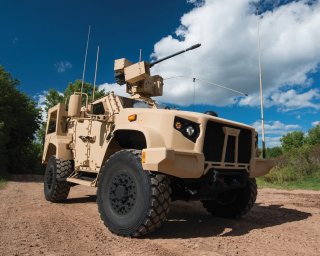Oshkosh Defense’s JLTV: The Military's Future Vehicle of Choice?
It is being called a Humvee-replacer. But does to live up to the hype?
Here's What You Need To Remember: The JLTV represents the next generation of automotive technology in a number of key respects, such as the ability to design a light tactical, mobile vehicle with substantial protective ability to defend against IEDs, roadside bombs, and other threats.
Oshkosh Defense has now built 10,000 of its Joint Light Tactical Vehicles for the U.S. Army, Marine Corps, and a growing sphere of international partners, hitting a milestone which may only be but a beginning to a decades-long developmental, production, and delivery trajectory.
The vehicle, originally envisioned as a hybrid combination between a high-speed, mobile, off-road vehicle and a heavily protected IED-stopping armored platform, has evolved into a complex, yet balanced mixture of the two. It is now used by as many as seven U.S. allied countries, to include the UK, Belgium, Montenegro, Slovenia, Lithuania, Brazil, and North Macedonia. More than 6,000 have already been fielded.
The JLTV represents the next generation of automotive technology in a number of key respects, such as the ability to design a light tactical, mobile vehicle with substantial protective ability to defend against IEDs, roadside bombs, and other threats. Senior Army developers have explained the technical and conceptual balance sought after by JLTV engineers who envisioned a highly versatile, mobile vehicle able to survive an entirely new threshold of threats when compared with previous tactical vehicles. The JLTV was built to fight with a level of underbody protection equivalent to the original MRAP-ATV (mine-resistant, ambush-protected—all-terrain vehicle) vehicle standards. Also, the vehicle is designed with modular armor, so that when the armor is not needed, the extra armor can come off and bring the weight of the vehicle down.
When compared with earlier light tactical vehicle models such as the Humvee, the JLTV is engineered with a much stronger, 250 to 360 horsepower engine and a 570-amp alternator able to generate up to 10 kilowatts of exportable power. Army developers explain that the JLTV is designed with enough onboard power to support the Army’s future network and be able to take advantage of the latest generation of diesel engine technology to maximize fuel economy.
The vehicle is built with a system called TAK-4i independent suspension designed to increase off-road mobility in rigorous terrain—a scenario quite likely should there be a major war. The JLTV is equipped with next-generation sensors and communications technologies to better enhance soldiers’ knowledge of a surrounding, fast-moving dynamic combat situation.
With the JLTV architecture, the vehicle will be able to streamline and more easily exchange and transmit information while ensuring that the maximum number of programs and applications are possible on any given computer or display screen. All of the JLTVs will be configured with what is called Variable Ride-Height Suspension, described as the ability to raise and lower the suspension to meet certain mission requirements such as the need to raise the suspension in high-threat areas and lower the suspension so that the vehicles can be transported by maritime preposition force ships. The JLTV is also reported to be air-sea-and-land transportable, able to transport on amphibious assault ships, fixed-wing aircraft such as a C-130, C-17, and C-5 as well as CH-47 and CH-53 helicopters.
The in-vehicle network approach is grounded in “open architecture,” meaning that information technology systems and electronics will all be built to commercial technical standards ensuring maximum interoperability. JLTV is aligning with specific Army technical standards, which will enable a single computer or system to run a host of interoperable applications and functions.
The JLTV, which can be armed with weapons such as a grenade launcher or .50-cal machine gun, has a central tire inflation system which is an on-the-fly system that can regulate tire pressure; the system can adjust tire pressure from higher pressures for higher speed conditions on flatter roads to much lower pressures in soft soil such as sand or mud, Army JLTV engineers have explained.
Kris Osborn is the defense editor for the National Interest. Osborn previously served at the Pentagon as a Highly Qualified Expert with the Office of the Assistant Secretary of the Army—Acquisition, Logistics & Technology. Osborn has also worked as an anchor and on-air military specialist at national TV networks. He has appeared as a guest military expert on Fox News, MSNBC, The Military Channel, and The History Channel. He also has a Masters Degree in Comparative Literature from Columbia University.
This piece first appeared earlier this year and is being republished due to reader interest.

